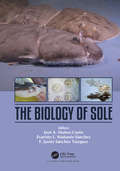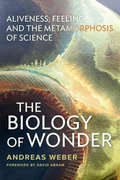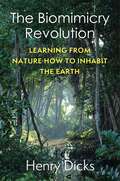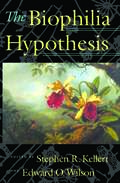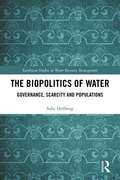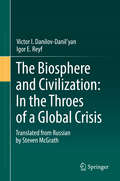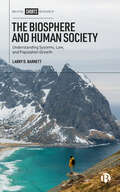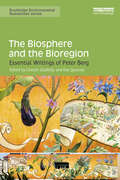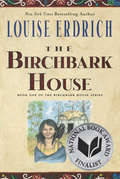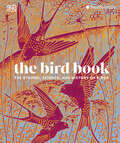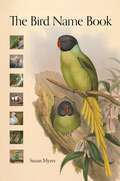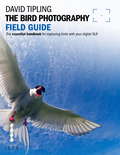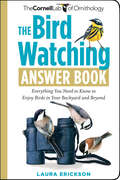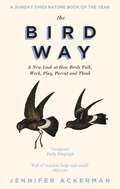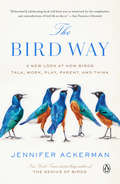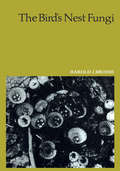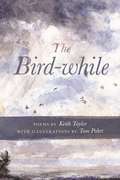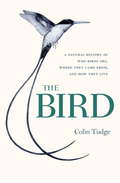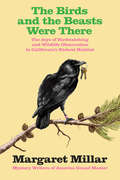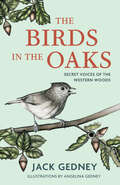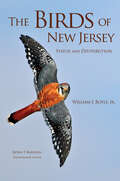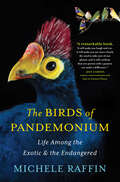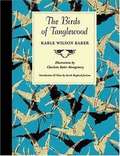- Table View
- List View
The Biology of Sole
by José A. Munoz-Cueto Evaristo Mañanós-Sánchez F. Javier Sánchez-VázquezThis book reviews up-to-date knowledge on the biology of sole (Solea senegalensis and S. solea). These flatfish species are increasingly important in Europe both from the ecological and production point of view. This book is divided into two sections: A. general fisheries, aquaculture and engineering overviews; B. physiological, developmental, rhythmic, welfare and genetic aspects which will be of immense interest for the aquaculture industry. Experts, from both academia and research institutes, provide their expertise on sole biology.
The Biology of Wonder: Aliveness, Feeling and the Metamorphosis of Science
by Andreas WeberA new way of understanding our place in the web of life from a scholar praised for his “graceful prose” (Publishers Weekly).The disconnection between humans and nature is perhaps one of the most fundamental problems faced by our species today. This schism is arguably the root cause of most of the environmental catastrophes unraveling around us. Until we come to terms with the depths of our alienation, we will continue to fail to understand that what happens to nature also happens to us.In The Biology of Wonder Andreas Weber proposes a new approach to the biological sciences that puts the human back in nature. He argues that feelings and emotions, far from being superfluous to the study of organisms, are the very foundation of life. From this basic premise flows the development of a "poetic ecology" which intimately connects our species to everything that surrounds us—showing that subjectivity and imagination are prerequisites of biological existence.Written by a leader in the emerging fields of biopoetics and biosemiotics, The Biology of Wonder demonstrates that there is no separation between us and the world we inhabit, and in so doing it validates the essence of our deep experience. By reconciling science with meaning, expression, and emotion, this landmark work brings us to a crucial understanding of our place in the rich and diverse framework of life—a revolution for biology as groundbreaking as the theory of relativity for physics.“Grounded in science, yet eloquently narrated, this is a groundbreaking book. Weber’s visionary work provides new insight into human/nature interconnectedness and the dire consequences we face by remaining disconnected.” —Richard Louv, author of Last Child in the Woods
The Biomimicry Revolution: Learning from Nature How to Inhabit the Earth
by Henry DicksModernity is founded on the belief that the world we build is a human invention, not a part of nature. The ecological consequences of this idea have been catastrophic. We have laid waste to natural ecosystems, replacing them with fundamentally unsustainable human designs. With time running out to address the environmental crises we have caused, our best path forward is to turn to nature for guidance.In this book, Henry Dicks explores the philosophical significance of a revolutionary approach to sustainable innovation: biomimicry. The term describes the application and adaptation of strategies found in nature to the development of artificial products and systems, such as passive cooling techniques modeled on termite mounds or solar cells modeled on leaves. Dicks argues that biomimicry, typically seen as just a design strategy, can also serve as the basis for a new environmental philosophy that radically alters how we understand and relate to the natural world. By showing how we can imitate, emulate, and learn from nature, biomimicry points us toward a genuinely sustainable way of inhabiting the earth.Rooted in philosophy, The Biomimicry Revolution has profound implications spanning the natural sciences, design, architecture, sustainability studies, science and technology studies, and the environmental humanities. It presents a sweeping reconception of what philosophy can be and offers a powerful new vision of terrestrial existence.
The Biophilia Hypothesis: The Quest To Make Conservation Profitable
by Edward O. Wilson Stephen R. Kellert Gregory Wilkins Aaron Katcher Cecilia Mccarthy Scott Mcvay"Biophilia" is the term coined by Edward O. Wilson to describe what he believes is humanity's innate affinity for the natural world. In his landmark book Biophilia, he examined how our tendency to focus on life and lifelike processes might be a biologically based need, integral to our development as individuals and as a species. That idea has caught the imagination of diverse thinkers.The Biophilia Hypothesis brings together the views of some of the most creative scientists of our time, each attempting to amplify and refine the concept of biophilia. The variety of perspectives -- psychological, biological, cultural, symbolic, and aesthetic -- frame the theoretical issues by presenting empirical evidence that supports or refutes the hypothesis. Numerous examples illustrate the idea that biophilia and its converse, biophobia, have a genetic component: fear, and even full-blown phobias of snakes and spiders are quick to develop with very little negative reinforcement, while more threatening modern artifacts -- knives, guns, automobiles -- rarely elicit such a response people find trees that are climbable and have a broad, umbrella-like canopy more attractive than trees without these characteristics people would rather look at water, green vegetation, or flowers than built structures of glass and concrete The biophilia hypothesis, if substantiated, provides a powerful argument for the conservation of biological diversity. More important, it implies serious consequences for our well-being as society becomes further estranged from the natural world. Relentless environmental destruction could have a significant impact on our quality of life, not just materially but psychologically and even spiritually.
The Biopolitics of Water: Governance, Scarcity and Populations (Earthscan Studies in Water Resource Management)
by Sofie HellbergBiopolitics refers to a form of politics concerned with administering and regulating the conditions of life at an aggregated level of populations. This book provides a biopolitical perspective on water governance and its effects. It draws on the work of Foucault to explore how notions of scarcity are used in strategies of governance and how such governance differentiates between different populations. Furthermore, the author investigates what such biopolitical regulation means for people’s lifestyles and the way they understand themselves and their moral responsibilities as humans, individuals and citizens. The book begins by investigating the global water agenda, with a particular emphasis on its focus on water for basic needs, and provides different examples of hydromentalities around the world. It also presents rich empirical details of one local case in South Africa. By carefully exploring the water 'stories' of water users, the book provides new perspectives on the relationship between water and power. Additionally, it offers an innovative methodological framework through which we can study the workings of governance more generally, and water governance specifically. It thereby contributes to the scholarship on water governance in relation to how water governance and technologies are part of producing subjectivities, notions of life and lifestyles and, more specifically, how the global water agenda can work so as to produce, or further entrench, distinctions between different lives and lifestyles. Ultimately, such differences between individuals and populations that are produced as an effect of water governance are assessed in relation to social sustainability.
The Biosphere and Civilization: In the Throes of a Global Crisis
by Victor I. Danilov-Danil'yan Igor E. ReyfThis monograph explores the dire ecological, social, and economic situations facing mankind through comprehensive analyses of global ecological issues, poverty, environmental stability and regulation, and sustainable development. Drs. Victor Danilov-Danil’yan and Igor Reyf discuss the development of ecology as a science, the increasing concern among scientists and public servants for the unsustainability of current economic and demographic trends, and the dire consequences our planet and civilization are already suffering as a result of the ongoing environmental and social crisis. They also address the philosophical implications of the crisis, and suggest possible solutions. The book conveys complex objects of study, namely the biosphere and the harmful anthropogenic processes it has been experiencing for decades, so that the work is accessible without omitting key components of the subject matter. Readers will learn about the social and economic contributors to a threatened biosphere, the mechanisms that maintain the stability of the global environment, and the scales at which sustainable development and preservation can be applied to initiate environmental regulation. Though intended to appeal to the general public and non-specialists, environmental researchers, organizations involved in sustainable development and conservation, and students engaged in ecology, environment, and sustainability studies will also find this book of interest.
The Biosphere and Human Society: Understanding Systems, Law, and Population Growth
by Larry D. BarnettHuman population growth is a serious biospheric problem yet is largely overlooked. Because of the neglect of demography, environmental policies—while well-intentioned—are unlikely to succeed. This book gives a concise review of world fertility rates and population growth, and offers a valuable summary of studies of the impact of overpopulation on the biosphere. In addition, the book explains key demographic variables to consider when formulating law and government policy relevant to childbearing, and it summarizes findings of social science research—findings that contradict popular assumptions about the impact of government interventions addressing the frequency of childbearing and immigration.
The Biosphere and the Bioregion: Essential Writings of Peter Berg (Routledge Environmental Humanities)
by Cheryll Glotfelty Eve QuesnelBioregionalism asks us to reimagine ourselves and the places where we live in ecological terms and to harmonize human activities with the natural systems that sustain life. As one of the originators of the concept of bioregionalism, Peter Berg (1937-2011) is a founding figure of contemporary environmental thought. The Biosphere and the Bioregion: Essential Writings of Peter Berg introduces readers to the biospheric vision and post-environmental genius of Berg. From books and essays to published interviews, this selection of writings represents Berg's bioregional vision and its global, local, urban, and rural applications. The Biosphere and the Bioregion provides a highly accessible introduction to bioregional philosophy, making Berg's paradigm available as a guiding vision and practical "greenprint" for the twenty-first century. This valuable compilation lays the groundwork for future research by offering the first-ever comprehensive bibliography of Berg's publications and should be of interest to students and scholars in the interdisciplinary fields of environmental humanities, environment and sustainability studies, as well as political ecology, environmental sociology and anthropology.
The Birchbark House (Birchbark House #1)
by Louise Erdrich<p>Omakayas, a seven-year-old Native American girl of the Ojibwa tribe, lives through the joys of summer and the perils of winter on an island in Lake Superior in 1847. <p>[This text is listed as an example that meets Common Core Standards in English language arts in grades 4-5 at http://www.corestandards.org.]</p>
The Birchbark House (Birchbark House #1)
by Louise ErdrichA fresh new look for this National Book Award finalist by Pulitzer Prize–winning novelist Louise Erdrich! This is the first installment in an essential nine-book series chronicling one hundred years in the life of one Ojibwe family and includes charming interior black-and-white artwork done by the author.She was named Omakakiins, or Little Frog, because her first step was a hop.Omakakiins and her family live on an island in Lake Superior. Though there are growing numbers of white people encroaching on their land, life continues much as it always has.But the satisfying rhythms of their life are shattered when a visitor comes to their lodge one winter night, bringing with him an invisible enemy that will change things forever—but that will eventually lead Omakakiins to discover her calling.By turns moving and humorous, this novel is a breathtaking tour de force by a gifted writer.The beloved and celebrated Birchbark House series by Louise Erdrich includes The Birchbark House, The Game of Silence, The Porcupine Year, Chickadee, and Makoons, with more titles to come.
The Bird Book: The Stories, Science, and History of Birds
by DKDelve into the fascinating world of birds through astonishing photography and clear explanations in this absorbing global guideBirds are dinosaurs, with a history going back millions of years. Our fascination with them runs deep in history and our close association is reflected in creation stories, myths, legends, songs, and children's stories.This book explores both the natural history of birds and that deep cultural connection. From their evolution and anatomy to their behavior and diversity, spanning tiny dunnocks hiding in bushes to ostriches strong enough to knock out a lion. Articles cover a group, such as hawks, finches, swans, or birds of paradise, moving the focus away from a predictable species-by-species account and allowing for truly global coverage. Discover the bold nature of European Robins and why they are associated with Christmas; the mythical Alkonost, with the body of a bird of paradise but the head of a woman; and learn about eagles, from their hunting prowess to the myriad stories and symbolism associated with them. Packed with information, and beautiful photography and illustrations, The Bird Book is a must-have for nature enthusiasts.
The Bird Name Book: A History of English Bird Names
by Susan MyersA marvelously illustrated A-to-Z compendium of bird names from around the globeThe Bird Name Book is an alphabetical reference book on the origins and meanings of common group bird names, from “accentor” to “zeledonia.” A cornucopia of engaging facts and anecdotes, this superbly researched compendium presents a wealth of incisive entries alongside stunning photos by the author and beautiful historic prints and watercolors. Myers provides brief biographies of prominent figures in ornithology—such as John Gould, John Latham, Alfred Newton, and Robert Ridgway—and goes on to describe the etymological history of every common group bird name found in standardized English. She interweaves the stories behind the names with quotes from publications dating back to the 1400s, illuminating the shared evolution of language and our relationships with birds, and rooting the names in the history of ornithological discovery.Whether you are a well-traveled birder or have ever wondered how the birds in your backyard got their names, The Bird Name Book is an ideal companion.
The Bird Photography Field Guide: The Essential Handbook For Capturing Birds With Your Digital Slr (Field Guide Ser.)
by David TiplingThis is a comprehensive and practical guide to photographing birds living in a wide variety of landscapes and climates. Helpful maps and site information, along with travel advice and technical tips, ensure this book is a 'must have' for all bird photographers - and bird enthusiasts as well.
The Bird Photography Field Guide: The Essential Handbook For Capturing Birds With Your Digital Slr (Field Guide Ser.)
by David TiplingA specialist title aimed at bird watchers, this handy book contains all the expertise you need to make your bird-watching trip into a rewarding photo session: there is copious advice on equipment, technique and field craft, and a wealth of wonderful photos to inspire you. Finally, a section on the digital darkroom will help you turn your shots into perfect prints.
The Bird Watching Answer Book: Everything You Need to Know to Enjoy Birds in Your Backyard and Beyond
by Laura EricksonLearn the how’s and why’s of bird behavior, from flirtatious mating practices and gorgeous birdsong to flying south for the winter. In this lively reference book, Laura Erickson addresses hundreds of real-life questions sent in to the Cornell Lab of Ornithology, the world’s foremost authority on birds. <P><P> With expert advice on bird watching techniques and equipment, feeding and housing birds, protecting habitats, and much more, Erickson guides you through the intricacies of the avian world with a contagious passion for our feathered friends.
The Bird Way: A New Look at How Birds Talk, Work, Play, Parent, and Think
by Jennifer Ackerman'A celebration of the dizzying variety of bird life and behaviour, one that will enthral birders and non-birders alike' The ObserverFrom the New York Times bestselling author of The Genius of Birds, a radical investigation into the bird way of being, and the recent scientific research that is dramatically shifting our understanding of birds. 'There is the mammal way and there is the bird way.' This is one scientist's pithy distinction between mammal brains and bird brains: two ways to make a highly intelligent mind. But lately, scientists have taken a new look at bird behaviours they've previously dismissed as anomalies. What they're finding is upending the traditional view of how birds live, how they communicate, forage, court, survive. They're also revealing the remarkable intelligence underlying these activities, abilities we once considered uniquely our own - deception, manipulation, kidnapping, infanticide, but also, ingenious communication between species, collaboration, altruism and play. Some of these behaviours are biological conundrums that seem to push the edges of - well - birdness: A mother bird that kills her own infant sons, and another that selflessly tends to the young of other birds. Young birds that devote themselves to feeding their siblings and others so competitive they'll stab their nestmates to death. Birds that give gifts and birds that steal, birds that dance or drum, that paint their creations or paint themselves, and birds that summon playmates with a special call - and may hold the secret to our own penchant for playfulness and the evolution of laughter. Drawing on personal observations, the latest science, and her bird-related travel around the world, Ackerman shows there is clearly no single bird way of being. In every respect, in plumage, form, song, flight, lifestyle, niche, and behaviour, birds vary. It's what we love about them.'Biologist and bestselling author Jennifer Ackerman knows what she's talking about . . . Chapter by meatily evidence-based chapter, she lays out the assumptions that underpin our understanding of birds - and then pecks them apart . . . Her knack for catching the personalities of different species in gorgeous, playful prose further collapses comfortable barriers between the human and the birdlike . . . More than it is a book about birds - and it is, indisputably, a book about birds - The Bird Way is about diversity and tolerance. A little bird told me that's just what we need in 2020' Daily Telegraph, ***** (Five Stars)'Jennifer Ackerman is not a field researcher, but with her eye for a great story she converts the scientific findings of others into popular books. The real joy of her book is its close attention to some of the specialists of the region . . . Ackerman is also alive to the humour at play in field research' Mark Cocker, The Spectator
The Bird Way: A New Look at How Birds Talk, Work, Play, Parent, and Think
by Jennifer AckermanFrom the New York Times bestselling author of The Genius of Birds, a radical investigation into the bird way of being, and the recent scientific research that is dramatically shifting our understanding of birds -- how they live and how they think.&“There is the mammal way and there is the bird way.&” But the bird way is much more than a unique pattern of brain wiring, and lately, scientists have taken a new look at bird behaviors they have, for years, dismissed as anomalies or mysteries –– What they are finding is upending the traditional view of how birds conduct their lives, how they communicate, forage, court, breed, survive. They are also revealing the remarkable intelligence underlying these activities, abilities we once considered uniquely our own: deception, manipulation, cheating, kidnapping, infanticide, but also ingenious communication between species, cooperation, collaboration, altruism, culture, and play. Some of these extraordinary behaviors are biological conundrums that seem to push the edges of, well, birdness: a mother bird that kills her own infant sons, and another that selflessly tends to the young of other birds as if they were her own; a bird that collaborates in an extraordinary way with one species—ours—but parasitizes another in gruesome fashion; birds that give gifts and birds that steal; birds that dance or drum, that paint their creations or paint themselves; birds that build walls of sound to keep out intruders and birds that summon playmates with a special call—and may hold the secret to our own penchant for playfulness and the evolution of laughter. Drawing on personal observations, the latest science, and her bird-related travel around the world, from the tropical rainforests of eastern Australia and the remote woodlands of northern Japan, to the rolling hills of lower Austria and the islands of Alaska&’s Kachemak Bay, Jennifer Ackerman shows there is clearly no single bird way of being. In every respect, in plumage, form, song, flight, lifestyle, niche, and behavior, birds vary. It is what we love about them. As E.O Wilson once said, when you have seen one bird, you have not seen them all.
The Bird's Nest Fungi
by Harold J. BrodieThe intriguing Bird's Nest Fungi (Nidulariaceae) of forest, meadow, and garden have been familiar to botanists since 1601, but only relatively recently has the significance of their peculiar form been realized. Dr Brodie traces the long controversy that arose when Bird's Nest Fungi were first classified as seed plants because of the numerous seed-like bodies contained in their small cup-shaped fruit bodies. The 'seeds' are now known to contain spores like those of other fungi such as puffballs, to which the Nidulariaceae are related. Present-day research has shown that certain Bird's Nest Fungi produce chemicals having previously unrecognized molecular structure. Between these milestones Dr Brodie reveals the solution to the mystery of the dispersal of the 'eggs' from the 'bird's nest': the fruit bodies are splash guns from which the reproductive spores are ejected by the force of falling raindrops. This explanation of the phenomenon is supported by copious observations and hitherto unpublished experiments.All known species of Nidulariaceae, including many only recently recognized, are described in this volume. All aspects of growth, structure, development, and life-cycle of these fungi, both in nature and in laboratory culture, are reported in a modern, comprehensive treatment of a subject which is of interest not only to mycologists but to amateur naturalists as well.
The Bird-while (Made in Michigan Writers Series)
by Keith Taylor“A Bird-while. In a natural chronometer, a Bird-while may be admitted as one of the metres, since the space most of the wild birds will allow you to make your observations on them when they alight near you in the woods, is a pretty equal and familiar measure” (Ralph Waldo Emerson’s Journal, 1838). Without becoming didactic or pedantic about the spiritual metaphor hidden in the concept of the “bird-while,” Keith Taylor’s collection evokes certain Eastern meditative poets who often wrote in an aphoristic style of the spirit or the mind mirroring specific aspects of the natural world. The Bird-while is a collection of forty-nine poems that meditate on the nature—both human and non-human—that surrounds us daily. Taylor is in the company of naturalist poets such as Gary Snyder and Mary Oliver—poets who often drew from an Emersonian sensibility to create art that awakens the mind to its corresponding truths in the natural world. The book ranges from the longer poem to the eight line, unrhymed stanza similar to that of the T'ang poet Han-Shan. And without section breaks to reinforce the passing of time, the collection creates greater fluidity of movement from one poem to the next, as if there is no beginning or end, only an eternal moment that is suspended on the page. Tom Pohrt’s original illustrations are scattered throughout the text, adding a stunning visual element to the already vivid language. The book moves from the author’s travel accounts to the destruction of the natural world, even species extinction, to more hopeful poems of survival and the return of wildness. The natural rhythm is at times marred by the disturbances of the twenty-first century that come blaring into these meditations, as when a National Guard jet rumbles over the treeline upsetting a hummingbird, and yet, even the hummingbird is able to regain its balance and continue as before. At its core, Taylor’s collection is a reminder of Emerson’s idea that natural facts are symbols of spiritual facts. These well-crafted poems will be easily accessible to any literary audience, with a more particular attraction to readers of contemporary poetry sensitive to the marriage of an Eastern sensibility with contemporary American settings and scenes.
The Bird: A Natural History of Who Birds Are, Where They Came From, and How They Live
by Colin TudgeOriginally published: Consider the birds: who they are and what they do. London: Allen Lane, 2008.
The Birds and the Beasts Were There: The Joys of Birdwatching and Wildlife Observation in California's Richest Habitat
by Margaret MillarSanta Barbara in the 1960s was home to two of the 20th century’s most important mystery writers, Margaret Millar and her husband, Ken (Ross Macdonald). It was also home to nearly 400 species of bird. This is the charming story of Ken and Maggie’s quest to see them all. The addiction that is birdwatching comes to vivid life in Margaret Millar’s delightful memoir of her early days as a naturalist. Part autobiography and part birdwatcher’s journal, it is a moving elegy to a bygone place and time. Millar brings her meticulous plotting and no small amount of suspense to these charming stories of a belligerent brown towhee named Houdunit, a larcenous raven called Melanie, and a rat who carefully ferments his grapes before eating them, to name only a few. Ornithology was a passion for both Ken and Maggie and they devoted their lives to it with the same keen sense of detail and, in the case of Margaret, storytelling vigor as they brought to their writing. In this book, the only memoir she wrote, Millar takes us on her journey from curious amateur to obsessive completionist. It is a phenomenon nearly any birding enthusiast will recognize. Ken and Margaret Millar were founding members of the Santa Barbara Audubon Society.
The Birds in the Oaks: Secret Voices of the Western Woods
by Jack GedneyThe first book on the birds of California's oaks, from our most lyrical and observant wanderer of the woods.With charm and delight, The Birds in the Oaks introduces us to the birds who burrow, forage, and soar among California's keystone trees. The mighty oak hosts a multitude of avian denizens—from canopy hoppers to ground nesters to short-billed surface pluckers—who rely on the trees' well-stocked pantry of acorns, insects, and flowers for sustenance and shelter. Spunky kinglets, crimson-eyed towhees, cuddle-craving bushtits, intrepid nuthatches, and impudent wrens are among the many memorable cast members in this pageant of oak-allied birds.Jack Gedney lyrically conveys the beautiful, comic, and endearing qualities of over fifteen bird species, each profile paired with an illustration by Angelina Gedney. His bird-filled tales of adaptation, ingenuity, and sheer persistence also bring to light the warp and weft of cross-species interdependence. The Birds in the Oaks reveals to us the utter joy of birds, the superabundant world of the oaks, and the innumerable interconnections these living beings create.
The Birds of New Jersey: Status and Distribution
by William J. BoyleNew Jersey provides some of the most varied and exciting birding in North America, and more than 450 species have been recorded in the state. Yet there has been no comprehensive and readily available guide to the status and distribution of all these species--until now. The Birds of New Jersey is the most up-to-date and succinct guide for the birds of New Jersey and includes all species known to the state from historical times to the present. Featuring over 200 color photos of rarities and regular species, this book authoritatively provides individual entries that include a summary of status and seasonal distribution, and comments on changes over time. Detailed color-coded maps accompany species accounts, and for species recorded five or fewer times, dates and locations of each record are noted. The introduction examines the state's geography, the history of bird records, and background information to species accounts, and the extensive bibliography guides birders to original sources used in the book. This is the essential resource for birders, ornithologists, and nature enthusiasts interested in the birds of New Jersey and the greater surrounding region. Most up-to-date status and distribution guide for New Jersey and surrounding region All bird species known to the state Species accounts describe the preferred habitat and abundance of species Range maps in color detail seasonal distribution For migratory birds, spring and fall migration times indicated More than 200 color photographs of rare and common species
The Birds of Pandemonium: Life Among The Exotic And The Endangered
by Michele Raffin“Michele Raffin has made an important contribution to saving endangered birds, and her book is a fascinating and rarely seen glimpse behind the scenes. The joy she gets from her close relationships with these amazing animals and her outsized commitment to them comes through loud and clear in this engaging and joyful book.” —Dominick Dorsa, Curator of Birds, San Francisco ZooEach morning at first light, Michele Raffin awakens to the bewitching music that heralds another day at Pandemonium Aviaries—a symphony that swells from the most vocal of over 350 avian throats representing over 40 species. “It knocks me out, every day,” she admits. Pandemonium Aviaries is a conservation organization dedicated to saving and breeding birds at the edge of extinction, including some of the largest populations of rare species in the world. And their behavior is even more fascinating than their glorious plumage or their songs. They fall in love, they mourn, they rejoice, they sacrifice, they have a sense of humor, they feel jealous, they invent, plot, cope, and sometimes they murder each other. As Raffin says, “They teach us volumes about the interrelationships of humans and animals.”Their stories make up the heart of this book. There’s Sweetie, a tiny quail with an outsize personality; the inspiring Oscar, a Lady Gouldian finch who can’t fly but finds a way to reach the highest perches of his aviary to roost. The ecstatic reunion of a disabled Victoria crowned pigeon, Wing, and her brother, Coffee, is as wondrous as the silent kinship that develops between Amadeus, a one-legged turaco, and an autistic young visitor. Ultimately, The Birds of Pandemonium is about one woman’s crusade to save precious lives, bird by bird, and offers insights into how following a passion can transform not only oneself but also the world.“Delightful . . . full of wonderful accounts of bird behavior, demonstrating caring, learning, sociability, adaptability, and a will to live. Its appeal is ageless, her descriptions riveting, and her devotion to the birds remarkable.” —Joanna Burger, author of The Parrot Who Owns Me: The Story of a Relationship“A remarkable book. Reading about the birds of Pandemonium will make you laugh and cry; it will make you see more clearly the need to take care of our planet; and it will confirm that one person with a passion can make a difference.” —Jeff Corwin, nature conservationist and host, Animal Planet“The Birds of Pandemonium touched me deeply . . . This book is about reconnecting with the nature of birds, and the nature of ourselves.” —Jon Young, author of What the Robin Knows
The Birds of Tanglewood
by Karle Wilson Baker Sarah Ragland Jackson Charlotte Baker MontgomeryIn the intimate language of one who watched birds daily, Karle Wilson Baker brought readers face to face with the wonders of the East Texas woods in the 1930s. She wrote about tiny warblers, industrious chickadees, and purple finches; the aery trills and tantalizing color flashes of the hummingbirds; the bell tones of the woodthrush; the daily visits and rare drop-ins of the prolific bird life of the region. In a daily diary she kept throughout her life, Baker recorded her observations of the many birds that lived in the heavily wooded setting of her Nacogdoches home, called Tanglewood. When her family moved from the house, she collected her essays on bird life into this volume, illustrated by her daughter Charlotte and published in 1930. Her little classic speaks with the voice of her times to readers today who enjoy their avian companions.
